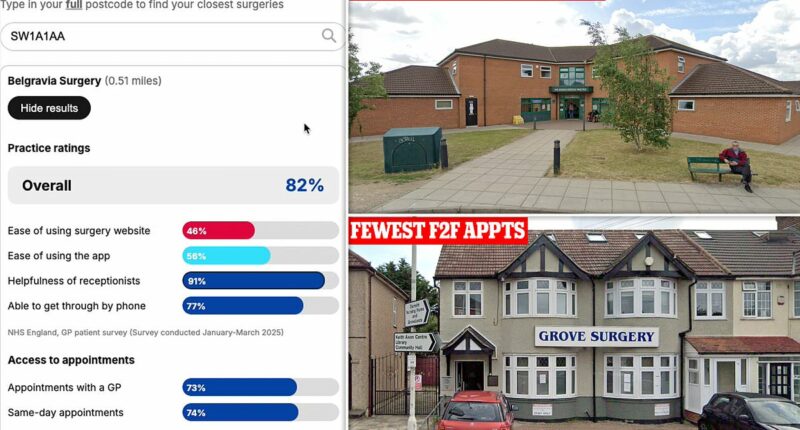Share this @internewscast.com
Ever wondered if your GP practice is up to scratch?
Well, now you can find out with MailOnline’s brilliant new search tool.
Powered with official NHS figures for all 6,000-plus surgeries in England, it reveals how many patients you’re competing with for precious appointments.
Type your full postcode into our tool to also discover how busy the phone lines are every morning and whether GPs are outnumbered by receptionists.
On top of that, it shows how many patients rate the practice as being ‘good’, as well as how helpful the admin staff are.
The practices with the biggest patient/doctor ratios
Using NHS general practice workforce statistics for May, MailOnline is able to name and shame the most understaffed surgeries.
We compared the numbers of full-time-equivalent GPs at every practice against the number of patients registered there.
FTE is considered a more accurate measure compared to a simple headcount, given how swathes of doctors only work part-time.
Excluding surgeries with fewer than one FTE GP, topping our table was The Sidings Medical Practice in Boston, Lincolnshire – one GP to 12,306 patients.
According to the data, it was followed by The Grange Medical Practice, just north of Huddersfield, West Yorkshire (1/11,629 patients) and JS Medical Practice in London’s Wood Green suburb (1/11,533).

The Sidings Medical Practice in Boston has the highest GP – patient ratio of one medic per 12,306 patients
Under widely accepted guidelines, practices shouldn’t have more than 1,800 patients on their lists for every full-time equivalent GP employed.
Yet MailOnline’s investigation exposing the abysmal state of general practice reveals more than 3,000 breach this threshold – a little under half of all surgeries.
Experts say the system is like an ‘elastic band stretched to breaking point’.
The practices where doctors are most outnumbered by receptionists
Our investigation, using the same NHS figures, also exposed the chronic bloating of GP surgeries with admin staff such as receptionists.
At the most imbalanced, Trent View Medical Practice in Scunthorpe, there were 13.6 full-time equivalent admin staff members to every one GP.
Surgeries with less than one FTE GP were discounted from our analysis.
Similar levels were seen in Wood Green’s JS Medical Practice (13.5).
Only 364 surgeries of the 6,209 that provided data for the metric has a ratio of one-to-one or better.

Trent View Medical Practice in Scunthorpe had the most admin staff per GP (13.6)
Separately, MailOnline recently revealed the GP surgeries with the most unhelpful receptionists.
Thirty-nine practices scored a perfect 100 per cent – meaning no-one surveyed found their admin staff problematic.
All those scores are judged by patients themselves, with tens of thousands quizzed across the country.
The practices carrying out the fewest face-to-face appointments
Before Covid, about 80 per cent of GP appointments were done in-person, although this has since fallen to around 63.5 per cent nationally.
Our analysis, based on self-reported practice data given to NHS Digital, shows some individual surgeries fell far below this level.
At Grove Surgery in Romford, just 11 per cent of all appointments were done face-to-face. A whopping 80 per cent of consultations in May occurred over the phone there.

Data show that 80 per cent of appointments at Grove Surgery are over the phone
Out of other traditional brick and mortar surgeries, Grove Surgery was followed by Veritas Health Centre in South Yorkshire (13.8 per cent of appointments face to face) and Chapel Street Surgery in Billericay, Essex (14.8 per cent).
Patients have long expressed their frustration over access to timely GP appointments, particularly with regards to in-person appointments.
Campaign group Silver Voices has argued elderly people who feel uncomfortable revealing personal medical issues over the internet may be at risk of having important red flags missed.
The practices with the busiest phone lines
The 8am scramble when the phone lines open is one of patients’ biggest bugbears.
Many find themselves in long queues, only to finally get through when all appointments for the day have already gone.
As part of the NHS’s annual GP Patient Survey, patients were asked to rank specific aspects of their GP services, including the ease with which they could get through on the phone.
At Emersons Green Medical Centre in Bristol, just 3.2 per cent of patients said they were able to connect via phone easily.
The surgery, however, was listed as of July 17 this year as being ‘temporarily closed down’.
A member of staff for Green Valleys Health, the body responsible for running NHS services in the region, told MailOnline that the facility had been shut since October due to an issue with the water and heating system and no re-opening date had been set.
Similarly low levels were reported for patients at Saffron Health Partnership in Bedford (5.8 per cent) Diamond Health Group in Yeovil (7.5 per cent) and Parkwood Surgery in Hertfordshire (7.7 per cent).
The practices rated worst overall
Surveys show satisfaction with general practice has fallen to an all-time low, fuelled by the difficulty of getting through on the phone and securing face-to-face care.
Nationally, the patient-doctor ratio now stands at an average of 2,282 patients per full time equivalent GP – up almost a fifth compared with 2015.
The result is millions of patients being rushed through appointments, in scenes that have been compared to being ‘goods on a factory conveyor belt’.
As part of the annual NHS survey, patients are also asked to whether they think their overall experience of the practice is good.
When excluding specialist surgeries, Emersons Green once again scored the lowest overall satisfaction, with 31.6 per cent, followed closely behind by Higham Ferriers Surgery in Rushden, Northamptonshire (32.5 per cent) and Lees Medical Practice in Central London (33.3 per cent).
The data examined was collected between January and May 2025 depending on the report, and represents the latest comparable figures available. Each survey question posed to patients can return between one or thousands of responses.
NHS Digital classifies much of this data as ‘experimental’, a designation meaning it is still undergoing evaluation for quality.
As GP practices record the data themselves before it is sent to the NHS for collation, this can mean errors can occur which can influence the results.
MailOnline’s analysis also excluded specialist GP services, such as ones that primarily or only operate online or home visit appointments.
………………………………………………………………………………………………………………………….
What the GP practices said
A spokesperson for Diamond Health Group told MailOnline: ‘We’re pleased to say a package of measures – including a new approach to triaging calls, an improved phone system and recruiting more staff – has already led to significant improvements, with further work planned.
‘Our April 2025 CQC inspection, which rates us ‘good’ overall and ‘good’ for responsiveness, confirms how our patient participation group has been positive about the changes we have made based on feedback, and that ‘people could access the care, support and treatment they needed when they needed it’.
A spokesperson for Archway Medical Centre said: ‘At Archway Medical Centre, we recognise the wider issues within general practice in England, particularly regarding access to face-to-face appointments. But we are not an example of the problem. We are part of the solution. Rather than illustrating a failing in access, our data reflects a different way of delivering care—one that is designed around the needs and preferences of our patients.
‘We are a digital-first practice. Over 32,000 NHS patients have chosen to register with us, making us the largest GP practice within the North Central London Integrated Care Board. Our patient demographic is predominantly young and mobile. This cohort often finds conventional general practice inaccessible and, when faced with an acute medical issue, may otherwise attend A&E.
‘Archway Medical Centre offers them a modern, accessible alternative. The preference of this demographic is to conduct their daily life, including healthcare, digitally rather than attend in person. They expect a fast and responsive digital service (“the Amazon prime, mail online generation”), which is what Archway Medical Centre provides through our digital-first model that empowers patients to choose how they wish to consult. They can select face-to-face, telephone, or video appointments, and all patients who want to be seen in person are offered a face-to-face appointment within one working day, often on the same day.
‘This level of access far outpaces the national average, where waits of two weeks or more are common. We’ve achieved this by implementing a sophisticated and robust demand and capacity model on a platform that maps capacity to demand in real-time, ensuring responsive, high-quality care at all times.’











